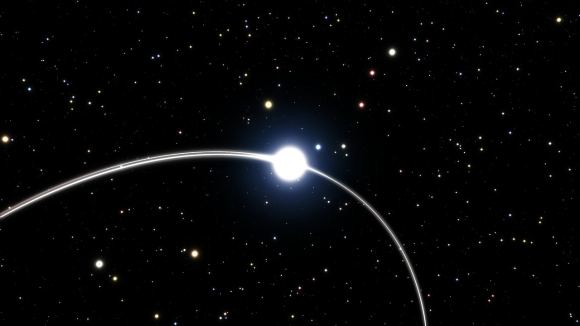At the center of our galaxy, roughly 26,000 light years from Earth, lies the Supermassive Black Hole (SMBH) known as Sagittarius A*. Measuring 44 million km across, this object is roughly 4 million times as massive as our Sun and exerts a tremendous gravitational pull. Since astronomers cannot detect black holes directly, its existence has been determined largely from the effect it has on the small group of stars orbiting it.
In this respect, scientists have found that observing Sagittarius A* is an effective way of testing the physics of gravity. For instance, in the course of observing these stars, a team of German and Czech astronomers noted subtle effects caused by the black hole’s gravity. In so doing, they were able to yet again confirm some of the predictions made by Einstein’s famous Theory of General Relativity.
Their study, titled “Investigating the Relativistic Motion of the Stars Near the Supermassive Black Hole in the Galactic Center“, was recently published in the Astrophysical Journal. As is indicated in the course of it, the team applied new analysis techniques to existing observations that were made by European Southern Observatory’s (ESO) Very Large Telescope (VLT) and other telescopes over the course of the past 20 years.
Artist’s impression of part of S2s orbit around the supermassive black hole at the center of the Milky Way. Credit: ESO/M. Parsa/L. Calçada
This star, which has 15 times the mass of our Sun, follows an elliptical orbit around the SMBH, completing a single orbit in about 15.6 years. At its closest, it gets to within 17 light hours of the black hole, which is the equivalent of 120 times the distance between the Sun and the Earth (120 AU). Essentially, the research team noted that S2 had the most elliptical orbit of any star orbiting the Supermassive Black Hole.
They also noted a slight change in its orbit – a few percent in the shape and about one-sixth of a degree in orientation. This could only be explained as being due to the relativistic effects caused by Sagittarius A* intense gravity, which cause a precession in its orbit. What this means is, the elliptical loop of S2’s orbit rotates around the SMBH over time, with its perihelion point aimed in different directions.
Interestingly enough, this is similar to the effect that was observed in Mercury’s orbit – aka. the “perihelion precession of Mercury” – during the late 19th century. This observation challenged classical Newtonian mechanics and led scientists to conclude that Newton’s theory of gravity was incomplete. It is also what prompted Einstein to develop his theory of General Relativity, which offered a satisfactory explanation for the issue.
Should the results of their study be confirmed, this will be the first time that the effects of general relativity have been precisely calculated using the stars that orbit a Supermassive Black Hole. Marzieh Parsa – a PhD student at the University of Cologne, Germany and lead author of the paper – was understandably excited with these results. As she stated in an ESO press statement:
“The Galactic Center really is the best laboratory to study the motion of stars in a relativistic environment. I was amazed how well we could apply the methods we developed with simulated stars to the high-precision data for the innermost high-velocity stars close to the supermassive black hole.“This study was made possible thanks to the high-accuracy of the VLT’s instruments; in particular, the adaptive optics on the NACO camera and the SINFONI near-infrared spectrometer. These instruments were vital in tracking the star’s close approach and retreat from the black hole, which allowed for the team to precisely determine the shape of its orbit and thusly determine the relativistic effects on the star.
In addition to the more precise information about S2’s orbit, the team’s analysis also provided new and more accurate estimates of Sagittarius A* mass, as well as its distance from Earth. This could open up new avenues of research for this and other Supermassive Black Holes, as well as additional experiments that could help scientists to learn more about the physics of gravity.
The central parts of our Galaxy, the Milky Way, as observed in the near-infrared with the NACO instrument on ESO’s Very Large Telescope. Credit: ESO/MPE/S. Gillessen et al.
The results also provided a preview of the measurements and tests that will be taking place next year. In 2018, the star S2 will be making a very close approach to Sagittarius A*. Scientists from around the world will be using this opportunity to test the GRAVITY instrument, a second-generation instrument that was recently installed on the Very Large Telescope Interferometer (VLTI).
Developed by an international consortium led by the Max Planck Institute for Extraterrestrial Physics, this instrument has been conducting observations of the Galactic Center since 2016. In 2018, it will be used to measure the orbit of S2 with even greater precision, which is expected to be most revealing. At this time, astrophysicists will be seeking to make additional measurements of the SMBH’s general relativistic effects.
Beyond that, they also hope to detect additional deviations in the star’s orbit that could hint at the existence of new physics! With the right tools trained on the right place, and at the right time, scientists just might find that even Einstein’s theories of gravity were not entirely complete. But in the meantime, it looks like the late and great theoretical physicist was right again!
And be sure to check out this video of the recent study, courtesy of the ESO:
Further Reading: ESO, Astrophysical Journal
The post Stars Orbiting Supermassive Black Hole Show Einstein was Right Again! appeared first on Universe Today.


No comments:
Post a Comment